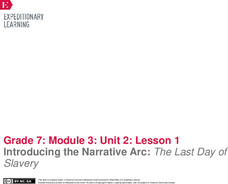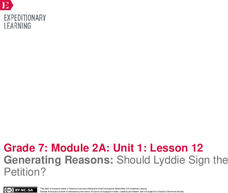Core Knowledge Foundation
Unit 4: The Time Machine by H. G. Wells Teacher Guide
Lead your readers into the fourth dimension as time travelers with a Core Knowledge Language Arts (CKLA) Teacher Guide of H. G. Wells's The Time Machine. The 144-page guide includes a unit calendar, introduction, nine lessons, teacher...
Core Knowledge Foundation
Unit 2: The Tempest by William Shakespeare Teacher Guide
Massive storms, shipwrecks, survivors stranded on an island ruled by an aging magician, and strange creatures—Shakespeare's The Tempest appeals to today's middle schoolers. For this unit, seventh graders read selections from an...
Core Knowledge Foundation
Unit 1: Hello, Universe by Erin Entrada Kelly Teacher Guide
Erin Entrada Kelly's award-winning novel, Hello, Universe is the anchor text in this 236-page teacher guide. The guide includes introductions to the Core Knowledge Language Arts (CKLA) program and the unit, a unit...
Penguin Books
Educator's Guide: The Da Vinci Code by Dan Brown
Dan Brown's The Da Vinci Code is filled with secrets. Help readers find the clues, solve the riddles and puzzles, and unwrap the mysteries with a six-page guide that includes before, during, and after reading discussion questions and...
Academy of American Poets
The African American Experience
Disrespect can be as subtle as a frown or a turn of a head. To prepare for a study of Toi Derricote's poem "The Weakness" class members create wordless skits that demonstrate subtle or not so subtle signs of disrespect. After a...
National Endowment for the Humanities
Theme Analysis in A Christmas Carol
Why does Charles Dickens have Ebenezer go from scrooge to light-hearted and generous? From "Bah, humbug!" to "God Bless Us, Every One!" After rereading Dickens' preface to A Christmas Carol, learners analyze quotations from the tale that...
National Endowment for the Humanities
Scrooge as He is Revealed during the Ghostly Experiences
Readers learn how to use both direct and indirect characterization clues provided by Charles Dickens to understand the complexity of Ebenezer Scrooge's character. Scholars collect evidence of comments Scrooge hears, how he responds to...
National Endowment for the Humanities
Language Analysis Based on Stave 1
Class members meet the original scrooge, the Dickens character whose name has become synonymous with a cold-hearted, tight-fisted, miser. Using the provided worksheet, readers closely examine context clues to determine the meanings of...
Teaching Tolerance
Where We Stand
Everyone is entitled to their own opinion. Academics learn strategies to share their opinions and agree or disagree with others in a respectful manner. The resource provides scenarios to help individuals form opinions and share them with...
EngageNY
Introducing the Narrative Arc: The Last Day of Slavery
Fix your mistakes. Scholars look over their end-of-unit assessments while the teacher focuses on common mistakes made among the class. Learners then make predictions about their next text, Frederick Douglass: The Last Day of Slavery, by...
EngageNY
Analyzing Character: Eliza Character Pyramid
Building a pyramid is not as hard as it looks! Scholars analyze the character of Eliza in Pygmalion by crafting a character pyramid about her. After discussing a model pyramid, pupils receive a blank Eliza Doolittle Character...
EngageNY
Gender and Pygmalion
Scholars take a close look at the role of gender presented in Pygmalion. They work in pairs to complete Gender Excerpts and Text-Dependent Questions. To finish, classmates discuss the role gender plays in the United States today.
EngageNY
Close Reading and Summarizing: The Epilogue of Pygmalion
Moving from what to why. After completing questions over the epilogue of Pygmalion, scholars take a close look at their Eliza Character Trackers and complete part II. They have collected a lot of details about Eliza's character and now...
EngageNY
Citing Evidence: The Ending of Pygmalion
Show time! After completing questions over Pygmalion section nine, scholars perform a reader's theater activity of pages 87-88. They then revisit their Eliza Character Trackers and add details as needed.
EngageNY
Text-to-Text Connections: Pygmalion
Scholars refer to a British Dialect/Slang anchor chart as they answer text-dependent questions over section eight of Pygmalion. While learners work on the questions, the teacher conducts check-ins on the progress of their independent...
EngageNY
Analyzing: Key Scenes in Pygmalion
Class members work on Pygmalion section seven text-dependent questions. They then act out part of the play in a reader's theater and finish the lesson by revisiting their Eliza Character Trackers, adding any new information they...
EngageNY
Mid-Unit Assessment: Evidence and Inference in Pygmalion
Scholars complete the Pygmalion mid-unit assessment to show their progress toward the unit's stated goals. The assessment requires learners to read text and successfully answer multiple choice and extended response questions.
EngageNY
Reading More Closely: Inferences and Evidence in Pygmalion
Learners read in section five of Pygmalion about Eliza's words and actions that shock the Victorian crowd. They answer text-dependent questions about the section, and then work with partners to add more details to their Eliza Character...
EngageNY
Introducing Readers Theater: Pygmalion
It's time to put on a show! Scholars participate in a Pygmalion Readers Theater. They discuss the text-dependent questions from the previous lesson and revisit the Eliza Character Tracker. To end the lesson, individuals reflect on their...
EngageNY
Analyzing Character: Launching Pygmalion, Part 2
Readers of Pygmalion use Eliza Character Tracker Parts one and two to notice and wonder about character analysis. They read text excerpts and mark details that show how Eliza feels and why she acts in certain ways. To finish, they...
EngageNY
Understanding Interactions: Launching Pygmalion, Part 1
During a reading of one section of Pygmalion, individuals begin thinking more deeply about identity. They also complete text-dependent questions and a close reading guide.
EngageNY
World Café to Analyze the Characters in Lyddie
Order up! Welcome to the World Café, where scholars engage in small-group discussions based on Katherine Paterson's novel Lyddie. As pupils circulate around the room, they talk with classmates about the novel's characters, setting,...
EngageNY
Generating Reasons: Should Lyddie Sign the Petition?
Scholars synthesize evidence from Katherine Paterson's Lyddie to create a list of the pros and cons of Lyddie signing a petition about working conditions. They use the Lyddie's Decision anchor chart to record their thoughts and ideas...

























